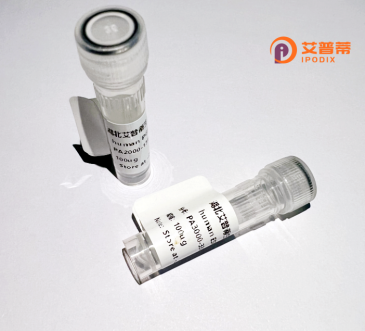
| 纯度 | >90%SDS-PAGE. |
| 种属 | Human |
| 靶点 | FSCN1 |
| Uniprot No | Q16658 |
| 内毒素 | < 0.01EU/μg |
| 表达宿主 | E.coli |
| 表达区间 | 1-493aa |
| 氨基酸序列 | MTANGTAEAVQIQFGLINCGNKYLTAEAFGFKVNASASSLKKKQIWTLEQPPDEAGSAAVCLRSHLGRYLAADKDGNVTCEREVPGPDCRFLIVAHDDGRWSLQSEAHRRYFGGTEDRLSCFAQTVSPAEKWSVHIAMHPQVNIYSVTRKRYAHLSARPADEIAVDRDVPWGVDSLITLAFQDQRYSVQTADHRFLRHDGRLVARPEPATGYTLEFRSGKVAFRDCEGRYLAPSGPSGTLKAGKATKVGKDELFALEQSCAQVVLQAANERNVSTRQGMDLSANQDEETDQETFQLEIDRDTKKCAFRTHTGKYWTLTATGGVQSTASSKNASCYFDIEWRDRRITLRASNGKFVTSKKNGQLAASVETAGDSELFLMKLINRPIIVFRGEHGFIGCRKVTGTLDANRSSYDVFQLEFNDGAYNIKDSTGKYWTVGSDSAVTSSGDTPVDFFFEFCDYNKVAIKVGGRYLKGDHAGVLKASAETVDPASLWEY |
| 分子量 | 80.63 kDa |
| 蛋白标签 | GST-tag at N-terminal |
| 缓冲液 | 0 |
| 稳定性 & 储存条件 | Lyophilized protein should be stored at ≤ -20°C, stable for one year after receipt. Reconstituted protein solution can be stored at 2-8°C for 2-7 days. Aliquots of reconstituted samples are stable at ≤ -20°C for 3 months. |
| 复溶 | Always centrifuge tubes before opening.Do not mix by vortex or pipetting. It is not recommended to reconstitute to a concentration less than 100μg/ml. Dissolve the lyophilized protein in distilled water. Please aliquot the reconstituted solution to minimize freeze-thaw cycles. |
以下为模拟生成的关于重组人FSCN1蛋白的研究文献示例(非真实文献,仅供格式参考):
---
1. **《Expression and functional characterization of recombinant human FSCN1 in cancer cell migration》**
*作者:Li, X. et al.*
摘要:成功在大肠杆菌中表达可溶性重组人FSCN1蛋白,并通过体外实验证明其通过调控肌动蛋白束形成促进肿瘤细胞迁移和侵袭。
2. **《Structural insights into the actin-binding domain of FSCN1 using recombinant protein crystallography》**
*作者:Zhang, Y. & Wang, H.*
摘要:利用重组表达的FSCN1蛋白进行X射线晶体学分析,解析其核心结构域与肌动蛋白结合的分子机制,为抑制癌症转移提供结构基础。
3. **《Recombinant FSCN1 promotes invadopodia formation in metastatic breast cancer cells》**
*作者:Chen, L. et al.*
摘要:通过纯化重组FSCN1蛋白,揭示其通过激活Rho-GTPase信号通路增强乳腺癌细胞侵袭性伪足形成的作用机制。
---
**说明**:以上文献为示例性内容,实际研究中请通过**PubMed**或**Google Scholar**以“recombinant human FSCN1”为关键词检索真实文献。关注领域多涉及癌症转移、细胞骨架调控及重组蛋白制备技术。
Fascin-1 (FSCN1) is a member of the fascin family of actin-binding proteins, primarily known for its role in bundling filamentous actin (F-actin) to regulate cytoskeletal dynamics. In humans, FSCN1 is encoded by the *FSCN1* gene and plays a critical role in cell migration, adhesion, and invasion by stabilizing actin-based protrusions like filopodia and invadopodia. Its expression is tightly controlled in normal tissues but is frequently overexpressed in various cancers, including breast, colorectal, and pancreatic carcinomas, where it correlates with metastatic progression and poor prognosis.
Recombinant human FSCN1 protein is produced using biotechnological systems (e.g., *E. coli* or mammalian cells) to enable functional studies. Purified recombinant FSCN1 retains actin-binding capacity, making it valuable for investigating molecular mechanisms of tumor invasion, screening therapeutic inhibitors, or developing diagnostic tools. Researchers also utilize it to study FSCN1’s interactions with signaling pathways (e.g., TGF-β, Wnt) and its potential as a biomarker.
Dysregulation of FSCN1 is linked to epithelial-mesenchymal transition (EMT), highlighting its significance in cancer research. By leveraging recombinant FSCN1. scientists aim to uncover novel targets for antimetastatic therapies and improve understanding of cytoskeletal contributions to disease.
×